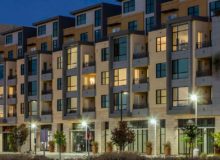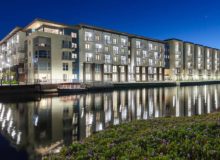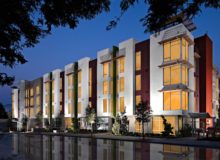Marin Independent Journal
February 27, 2023
Richard Halstead
A proposal to build 250 apartments on state land adjacent to San Quentin State Prison would result in no significant environmental impacts, according to an analysis of the project.
The draft environmental impact report on the Oak Hill Apartments project is open for public comment through April 10. The draft is available at bit.ly/41ArwrN. A public meeting is set for 6 p.m. March 16 at San Rafael High School.
The state has made state-owned parcels available to developers in an effort to address the shortage of affordable housing. The state is providing 5 acres of land it owns between the prison and the Larkspur ferry terminal to the developers at no cost.
At least half of the 250 apartments will be reserved for Marin County educational staff and county employees. The dwellings will be owned jointly by the county and the Marin County Office of Education. The remainder of the apartments will be reserved for low-income renters. All of the apartments will be rentals.
Because the apartments will be built on state-owned land, all of the entitlements and permitting for the project, including analysis required under the California Environmental Quality Act, will be handled by the state’s Department of General Services.
Neither the county nor Larkspur, which includes the area within its sphere of influence, will have any say in the approval process.
Under county zoning of the parcel, no more than 21 single-family houses could be built on the site. The state, however, is exempt from the county’s zoning regulations.
One of the chief concerns expressed about the project is the effect it would have on traffic. The proposed project site is off Sir Francis Drake Boulevard between Interstate 580 and Highway 101.
Backups on Sir Francis Drake Boulevard in the area can become severe if eastbound traffic on the Richmond-San Rafael Bridge is impeded during evening commute hours.
“I’m skeptical on how they’re claiming that there is not going to be a significant traffic impact at that location,” said David Herr, who lives in the Drakes Cove neighborhood adjacent to the proposed building site.
“The traffic study tends to focus on vehicle miles traveled over the entire corridor,” Herr said. “It doesn’t necessarily focus on that particular intersection. That is where most of the traffic impact for Drakes Cove residents is going to be.”
The project proposes installing a traffic light at the entrance and converting an eastbound acceleration lane on Sir Francis Drake Boulevard into a left-turn lane into the complex.
The environmental impact report identifies seven alternative versions of the project for discussion purposes. Because all of the project’s environmental effects can be reduced to an acceptable level using mitigation measures alone, the California Environmental Quality Act does not require the identification of a preferred alternative.
Four of the alternatives are options for entry into the project. Alternative two is identical to the proposed project access, except it would also place a stop sign at the intersection where Oak Hill residents leaving the site would connect with Sir Francis Drake Boulevard.
Alternative three would include the traffic light and the left-turn lane into the site. This scheme, however, also calls for an internal road through the site linking to Drakes Cove Road with a stop sign at the intersection with Drakes Cove Road.
Alternative four proposes placing the traffic signal at the intersection with Drakes Cove Road instead of the project site entrance. It would also link the project to Drakes Cove Road via a private driveway with a stop sign.
Additionally, Drakes Cove Road would be widened at its intersection with Sir Francis Drake Boulevard in order to accommodate both a right-turn lane and a left-turn pocket onto Sir Francis Drake Boulevard.
Alternative five would include the traffic light and the left-turn lane into the site, but it would eliminate a left-hand turn pocket on Sir Francis Drake Boulevard at the Drakes Cove Road intersection. Under this proposal, vehicles traveling east on Sir Francis Drake Boulevard would no longer be able to turn left onto Drakes Cove Road.
Regarding the alternatives involving changes to Drakes Cove Road, Herr said, “That’s just fluff because we told them from the beginning that there is not going to be a shared access with Drakes Cove Road. It’s technically a private road, not a public street where they can do whatever they want.”
Under Senate Bill 743, signed by Gov. Jerry Brown in 2013, automobile delay may no longer be considered a significant impact for the purposes of CEQA.
When judging whether a transportation effect is significant, EIRs must now focus on four areas: whether projects conflict with existing transportation plans or policies; whether they result in an excessive increase in vehicles miles traveled; whether they increase hazards due to their design; and whether they result in inadequate emergency access.
On all these scores, the Oak Hill study found no impacts requiring mitigation.
According to the analysis, which included a traffic study by W-Trans in Oakland, the proposed project is expected to generate an average of 1,360 trips per day, including 90 trips during the a.m. peak hour and 110 during the p.m. peak hour.
The EIR determined that the proposed project would increase traffic on Sir Francis Drake Boulevard by approximately 4% to 5% during the a.m. and p.m. peak hours, and across a typical 24-hour day.
“The Central Marin Fire Authority and Central Marin Police have reviewed the proposed project and determined that they will be able to meet the increase in service calls without increasing response times,” the report says.
The other three alternatives studied in the EIR were a no-project alternative; an all-electric design version of the project; and an alternative calling for the project’s site, which is in unincorporated Marin County, to be annexed by Larkspur.
Marin County supervisors rejected a request from Larkspur to claim credit for the 250 apartments at Oak Hill to meet its state mandated housing target.
County Administrator Matthew Hymel said that there are no discussions concerning Larkspur annexing the property.
“At a future date, if Larkspur initiates annexation of the property, we would work with Larkspur to consider how it impacts the implementation of our respective housing elements,” Hymel said.
Don Dickenson, president of the Marin County Planning Commission, noted that had the project been proposed on private land it could have been developed by right regardless, since it is included on the list of proposed housing sites in the county’s new housing element.
Dickenson said that he was surprised to learn from the EIR that the project site would be served by San Rafael City Schools. According to the EIR, both the San Rafael elementary school and San Rafael high school districts are at approximately 90% capacity.
“San Rafael City Schools believes that we have the capacity to accommodate students coming from the Oak Hills project,” said Jim Hogeboom, the district’s superintendent. “I have personally voiced my support for the project to bring much-needed affordable housing options for our educators.”









